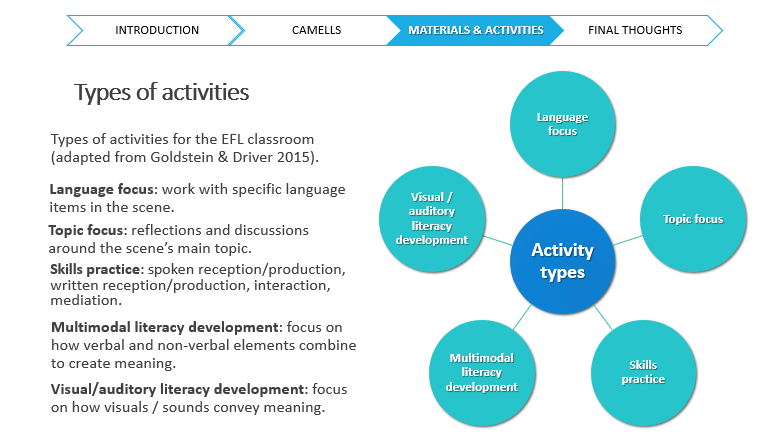ARDAA 2024: Paula Wood-Borque explores the use of films and series as pedagogical tools

Our team member Paula Wood-Borque participated in the conference organised by the French Association for Research in English Learning and Teaching (ARDAA) in the University Sorbonne Nouvelle (Paris, France). The conference was titled “Teaching and learning English as a Foreign Language in Educational Settings: Issues and Specificities”, and took place from the 26th to the 28th of June 2024.
In her presentation, titled “Films and series as pedagogical tools for the Secondary Education English as a Foreign Language classroom”, Paula presented an overview of her PhD project, focusing on the types of materials and activities that can be developed based on the multimodal analysis of scenes from films and series (in particular, those included in her corpus CAMELLS). For this, she provided several examples of different types of activities and how these can contribute to the development of students’ multiliteracies and skills. The abstract of her talk can be consulted as follows:
Films and series as pedagogical tools for the Secondary Education EFL classroom
Nowadays, audiovisual materials such as films and series are commonly used in the foreign language classroom due to their benefits as a source of simulated naturalistic speech and the variety of topics, accents and cultures they can bring to the classroom (Bednarek, 2018; Donaghy, 2019). Previous studies have found that using audiovisual materials in the English as a Foreign Language (EFL) classroom can have several positive effects, especially in relation to vocabulary acquisition (e.g. Rodgers & Webb, 2011; Puimège & Peters, 2020), development of listening skills (e.g. Webb & Rodgers, 2009; Feng & Webb, 2020) and overall second language speech processing skills (e.g. Bobkina et al., 2020; Wisniewska & Mora, 2020). In addition, it will be argued in this paper that bringing carefully chosen films and series into the classroom may also help develop students’ multiliteracies.
The main aim of this paper is to discuss the role that audiovisual materials can have as a pedagogical tool in the EFL classroom considering their advantages and disadvantages, and to explore how they can be adapted and exploited to enhance not only students’ verbal skills, but also their visual, media and film literacies. For this, the corpus of scenes from films and series CAMELLS (Corpus of Audiovisual Materials for English Language Learning in Secondary), which I have compiled, will be presented together with the tools and process of selection of titles and scenes. Different types of exploitations for the Secondary Education EFL classroom will be offered, guided by Communicative Language Teaching theories (Littlewood, 2001; Brandl, 2008), to discuss what competences and skills could be promoted. This will be complemented with the perceptions of a sample of EFL teachers in Secondary Education in Spain on the usefulness and benefits of the corpus, tools and exploitation suggestions.
References
Bednarek, M. (2018). Language and Television Series: A Linguistic Approach to TV Dialogue. Cambridge: Cambridge University Press.
Bobkina, J., Domínguez Romero, E. & Gómez Ortiz, M. J. (2020). Educational mini-videos as teaching and learning tools for improving oral competence in EFL/SLA university students. Teaching English with Technology. 20(3). 85-95.
Brandl, K. (2008). Communicative Language Teaching in Action: Putting Principles to Work. Pearson Prentice Hall.
Donaghy, K. (2019). Using films to teach languages in a world of screens. In C. Herrero & I. Vanderschelden (Eds.). Using film and media in the language classroom: Reflections on researchled teaching (pp. 3-16). Multilingual Matters.
Feng, Y. & Webb, S. (2020). Learning vocabulary through reading, listening and viewing. Which mode of input is most effective? Studies in Second language Acquisition. 42, 499-523. doi:10.1017/S0272263119000494
Littlewood, W. (2001). Communicative Language Teaching: An Introduction. Cambridge: Cambridge University Press.
Puimège, Eva & Elke Peters. (2020). Learning formulaic sequences through viewing L2 television and factors that affect learning. Studies in Second Language Acquisition. 42, 525-549. doi:10.1017/S027226311900055X
Rodgers, M. & Webb, S. (2011). Narrow viewing: The vocabulary in related television programs. TESOL Quarterly, 45(4), 689-717. doi:10.5054/tq.2011.268062
Webb, S. & Rodgers, M. (2009). The lexical coverage of movies. Applied Linguistics, 30(3), 407-427. doi:10.1093/applin/amp010
Wisniewska, N. & Mora, J. C. (2020). Can captioned video benefit Second language pronunciation? Studies in Second Language Acquisition, 42, 599-624. doi:10.1017/S0272263120000029
